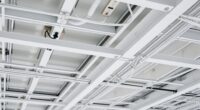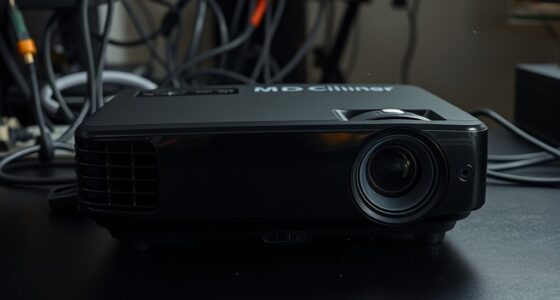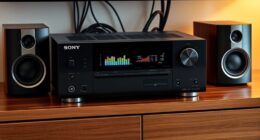Louder fans don’t automatically cool better; noise level doesn’t equal performance. Effective cooling depends on airflow and heat dissipation, not volume. Factors like blade shape, material quality, and design influence both noise and thermal efficiency. Knowing a fan’s heat output helps you understand its true performance. Focusing on airflow efficiency and thermal properties matters more than just size or speed. Keep exploring to discover what really affects your cooling and noise levels.
Key Takeaways
- Louder fans do not necessarily cool better; noise level doesn’t correlate directly with thermal performance.
- Effective cooling depends on airflow, heat dissipation, and heat transfer, not just fan size or speed.
- Noise can be minimized through airflow efficiency and vibration reduction, not solely by lowering fan speed.
- Material quality and blade design significantly influence both heat dissipation and noise levels.
- Understanding a fan’s heat output and thermal management features provides a better measure of cooling effectiveness than noise alone.
Debunking the Myth: Does Louder Always Mean Better Cooling?

Many people assume that louder fans cool better, but that’s not necessarily true. Instead, focus on acoustic efficiency, which measures how effectively a fan cools without excessive noise. A quieter fan can still provide excellent thermal management if designed properly. Noise levels don’t directly correlate with cooling performance; a louder fan might make more noise due to inefficient design, not better heat dissipation. Good thermal management depends on how well the fan moves air and how effectively it dissipates heat, not just its volume. High-quality fans balance airflow and noise, ensuring ideal cooling without unnecessary racket. So, don’t judge a fan’s capability solely by its noise level—consider its acoustic efficiency and overall design for real cooling performance. Additionally, understanding the contrast ratio of a projector can influence how well images are perceived in different lighting conditions, ultimately impacting your viewing experience.
Understanding Heat Output: What Does It Really Tell You?
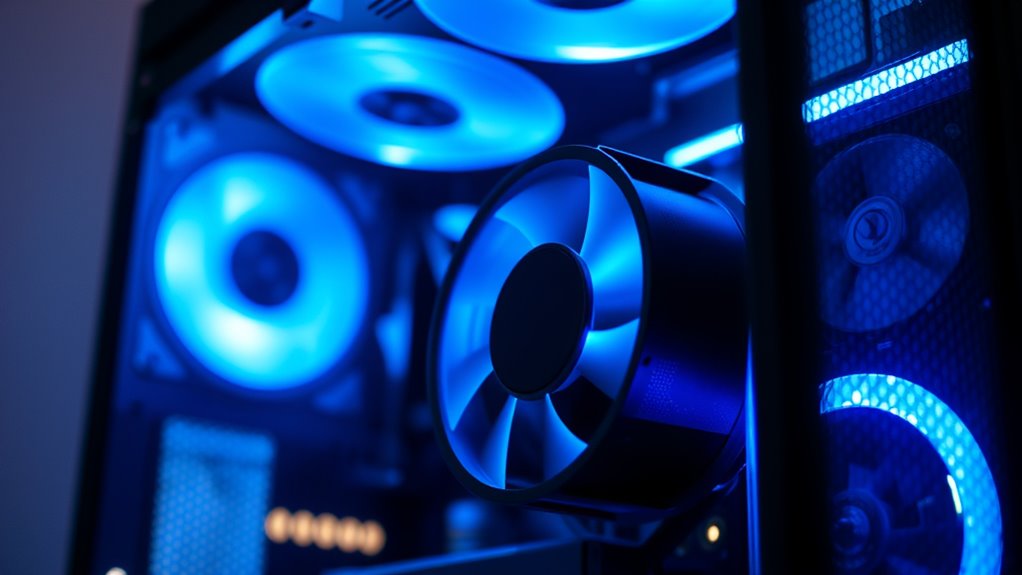
Understanding heat output provides a clearer picture of a fan’s true cooling capability beyond just noise levels. It reveals how effectively a fan manages thermal efficiency and how airflow direction impacts heat dissipation. To assess this, consider:
- Thermal Efficiency: A higher thermal efficiency means better heat transfer, cooling your space more effectively.
- Airflow Direction: Proper airflow direction ensures heat is moved away from hot spots, optimizing cooling.
- Heat Dissipation Rate: Look at how quickly the fan can remove accumulated heat from the area.
- Fan Design: Features like blade shape and motor placement influence heat output and overall performance.
Additionally, understanding the specific heat management features of a fan can help you select a model that aligns with your cooling needs.
This understanding helps you pick a fan that truly cools, not just sounds loud.
Factors That Influence Fan Noise and Heat Beyond Just Size and Speed
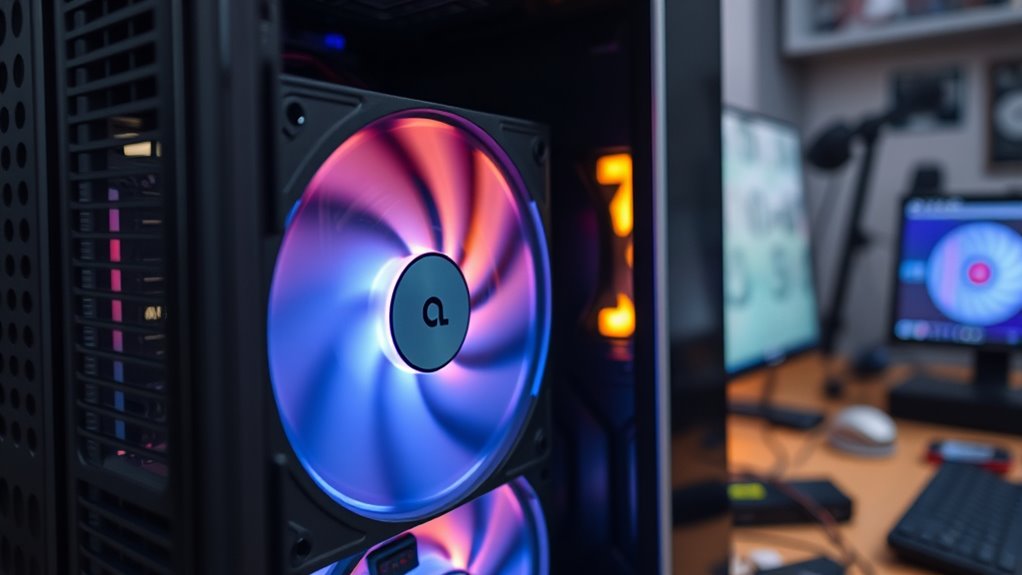
While size and speed are major factors, several other elements substantially influence a fan’s noise levels and heat output. Airflow efficiency plays a key role; a fan designed for ideal airflow moves air more quietly and effectively, reducing noise and heat buildup. Additionally, thermal conductivity impacts heat transfer; fans with components made from materials with high thermal conductivity disperse heat more efficiently, lowering overall temperatures. The design of blades, including their shape and angle, also affects both noise and cooling performance. Proper placement and mounting minimize vibrations that can increase noise. The use of high-quality materials in construction can further reduce unwanted noise and improve heat dissipation. By focusing on airflow efficiency and the thermal properties of materials, you can select a fan that operates quieter and cools better, beyond just considering size and speed.
Frequently Asked Questions
How Does Ambient Room Temperature Affect Fan Noise and Heat?
Higher room temperature makes your fan work harder, increasing fan noise and heat. When the room is warmer, your fan’s motor runs longer to cool the space, which can lead to more noise and heat production. Conversely, cooler room temperatures reduce the workload on your fan, resulting in quieter operation and less heat generated. Keeping your room at a comfortable temperature helps your fan run efficiently and quietly.
Can Airflow Direction Impact Cooling Efficiency More Than Fan Speed?
Think of airflow as a river guiding heat away from your device. Proper fan placement and airflow patterns can enhance cooling efficiency more than just cranking up fan speed. When you optimize airflow direction, you guarantee hot air escapes and cool air circulates effectively. This targeted approach prevents hotspots and keeps your system running smoothly, making airflow management more impactful than simply increasing fan speed.
What Role Do Fan Blade Design and Materials Play in Noise Levels?
Fan blade design and materials markedly influence noise levels. You’ll notice that blade aerodynamics reduces turbulence, minimizing noise during operation. Meanwhile, choosing materials with good acoustics, like rubber or foam, dampens sound vibrations. By optimizing blade shape and selecting sound-absorbing materials, you can enjoy quieter fans without sacrificing cooling performance. These design choices make a noticeable difference in noise reduction, helping your setup run more quietly and efficiently.
How Do Dust and Debris Influence Fan Performance and Heat Management?
Imagine you’re in a spaceship, and dust accumulation or debris blockage clogs your vents—just like with fans. Dust and debris settle on blades and inside vents, reducing airflow and making fans work harder. This hampers heat management, increases noise, and decreases efficiency. Regular cleaning prevents dust buildup, ensuring maximum performance and keeping your system cool and quiet, much like a well-maintained spaceship stays operational in space.
Are There Specific Settings to Optimize Noise Reduction Without Sacrificing Cooling?
You can optimize noise reduction without sacrificing cooling by adjusting fan speed settings. Lower the fan speed during light tasks to reduce noise, and increase it when cooling is needed. Use noise dampening features like vibration pads or insulated cases to further minimize sound. Consider customizing fan curves in your system’s BIOS or software, balancing airflow and noise levels to maintain effective cooling while keeping noise to a minimum.
Conclusion
Think of your computer’s cooling as a garden: loud fans are like noisy sprinklers, but that doesn’t mean they water better. True cooling is about balance, not just volume or size. By understanding what heat output really tells you, you become a gardener who nurtures plants wisely. So, don’t chase after the loudest or biggest—focus on the right tools, and your system will flourish quietly and efficiently.

